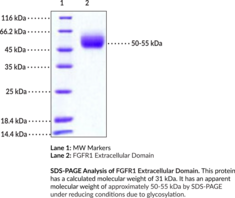Territorial Availability: Available through Bertin Technologies only in France
- Correlated keywords
- HEK 293 FGFR CD-331 FLT bFGFR1
- Product Overview:
Fibroblast growth factor receptor 1 (FGFR1) is a growth factor receptor with roles in cell migration, differentiation, and survival, as well as apoptosis, chemotaxis, and embryonic development.{60612,60615} It is composed of an N-terminal extracellular domain, which contains three immunoglobulin-like (Ig-like) domains, including the FGF ligand-binding domain, an acidic box, and a CAM-homology domain, a transmembrane domain, and a C-terminal tyrosine kinase domain. FGFR1 is expressed throughout the pre-differentiated mesenchyme of the cranium, in midfacial mesenchyme, and the endochondral skull base during early embryonic development, and broadly expressed in epithelial, osteogenic, and chondrogenic cell lineages by 10 to 13 weeks gestation.{60613} Upon ligand binding, FGFR1 dimerizes, resulting in autophosphorylation of the tyrosine kinase domain and activation of various intracellular signaling pathways, including the ERK/MAPK pathway.{60612} Mutations in FGFR1 induce various craniofacial dysostosis syndromes, such as Crouzon, Pfeiffer, and Jackson-Weiss syndromes that feature basicranial and midfacial deformities.{60613} FGFR1 amplifications, translocations, and fusions are associated with lung cancer, 8p11 myeloproliferative syndrome, and glioblastoma multiforme, respectively.{60614} Cayman’s FGFR1 Extracellular Domain (human, recombinant) can be used for enzyme activity assays. This protein consists of 275 amino acids, has a calculated molecular weight of 31 kDa, and a predicted N-terminus of Arg22 after signal peptide cleavage. By SDS-PAGE, under reducing conditions, the apparent molecular mass of the protein is 50-55 kDa due to glycosylation.
Cayman Chemical’s mission is to help make research possible by supplying scientists worldwide with the basic research tools necessary for advancing human and animal health. Our utmost commitment to healthcare researchers is to offer the highest quality products with an affordable pricing policy.
Our scientists are experts in the synthesis, purification, and characterization of biochemicals ranging from small drug-like heterocycles to complex biolipids, fatty acids, and many others. We are also highly skilled in all aspects of assay and antibody development, protein expression, crystallization, and structure determination.
Over the past thirty years, Cayman developed a deep knowledge base in lipid biochemistry, including research involving the arachidonic acid cascade, inositol phosphates, and cannabinoids. This knowledge enabled the production of reagents of exceptional quality for cancer, oxidative injury, epigenetics, neuroscience, inflammation, metabolism, and many additional lines of research.
Our organic and analytical chemists specialize in the rapid development of manufacturing processes and analytical methods to carry out clinical and commercial GMP-API production. Pre-clinical drug discovery efforts are currently underway in the areas of bone restoration and repair, muscular dystrophy, oncology, and inflammation. A separate group of Ph.D.-level scientists are dedicated to offering Hit-to-Lead Discovery and Profiling Services for epigenetic targets. Our knowledgeable chemists can be contracted to perform complete sample analysis for analytes measured by the majority of our assays. We also offer a wide range of analytical services using LC-MS/MS, HPLC, GC, and many other techniques.
Accreditations
ISO/IEC 17025:2005
ISO Guide 34:2009
Cayman is a leader in the field of emerging drugs of abuse, providing high-purity Schedule I-V Controlled Substances to federally-licensed laboratories and qualified academic research institutions for forensic analyses. We are certified by ACLASS Accreditation Services with dual accreditation to ISO/IEC 17025:2005 and ISO Guide 34:2009.





